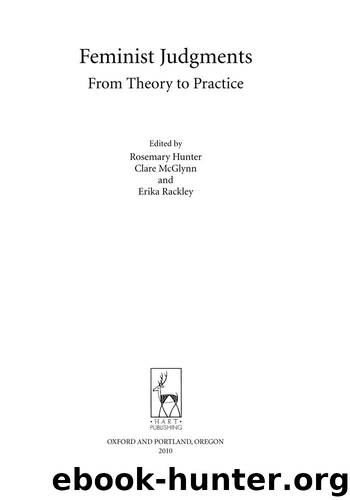Feminist Judgments: From Theory to Practice by Rosemary Hunter Clare McGlynn and Erika Rackley

Author:Rosemary Hunter, Clare McGlynn and Erika Rackley
Language: eng
Format: azw3
ISBN: 9781847317278
Publisher: Bloomsbury Publishing
Published: 2010-09-29T16:00:00+00:00
The problem with the law’s derivation of voluntary undertaking from de facto care-giving is that it ensures that questions of consent and capacity for care-giving are left unscrutinised. In Stone, the Court’s emphasis upon evidence of practical efforts by the couple to take responsibility for Fanny’s welfare obscured the disabilities and disadvantages that appear to have limited their consent to, and capacity for, the care-giving required.
Gender also looms large in this structural critique.17 Consider, for instance, snippets of conversation taken from the police interview with Gwendoline Dobinson. Implicit in the police evidence submitted to the court are the familiar signs of unequal, gendered relations of power within the household. According to the report, when Gwendoline was asked by the police why she did not take greater steps to help Fanny, she replied: ‘I daren’t. He is boss down there. I daren’t do anything unless he tells me’.18 The standard of care-giving expected of her was also gendered; the police interviewer explicitly alluded to her sex when criticising her for not recognising the seriousness of the situation: ‘You are a woman and you go into her bedroom. Your own commonsense would tell you that she needed attention?’19
Norrie argues persuasively that the concept of undertaking was deliberately ‘manipulated into action’ by the judges,20 who appreciated ‘they had no real basis in law for establishing a duty to act’,21 in order to ensure a conviction in the face of the harrowing death of Fanny Stone. The Court imposed a sentence of imprisonment on John Stone on the ground that it was needed to ‘mark the public disapproval’ attaching to his conduct.22 The most important objective was for the state to be seen to take symbolic action that would show something had been done to respond to the event. Although there was recognition of the vulnerabilities of the couple, there was a more powerful need for the state to apportion blame. In short, close examination of moral responsibility took second place to the urgent requirement to address a clear and terrible harm.
The consequence of law’s symbolic intervention, of course, was the discursive allocation of moral responsibility for Fanny’s welfare to John and Gwendoline alone. Yet what remains especially troubling about the original judgment is its failure to consider the couple’s responsibility for Fanny’s care in light of the broader network of care-giving within which they both existed. Much is made in the decision of Gwendoline Dobinson’s failure to act upon the advice of a neighbour, Mrs Wilson, and the local publican, Emily West, that she should contact social services or a doctor about Fanny’s situation. Some effort was made by the couple to seek out a doctor, but each attempt ended in failure and, as the Court of Appeal starkly noted, ‘Nothing more was done to enlist outside professional aid’.23 It is therefore perhaps surprising that the case suggests, at the same time, an apparent lack of judicial concern with the wider legal care-giving duties of the welfare state. In police interviews, both appellants
Download
This site does not store any files on its server. We only index and link to content provided by other sites. Please contact the content providers to delete copyright contents if any and email us, we'll remove relevant links or contents immediately.
American Kingpin by Nick Bilton(3510)
Future Crimes by Marc Goodman(3374)
The Meaning of the Library by unknow(2389)
Inside the Middle East by Avi Melamed(2233)
Why Nations Fail: The Origins of Power, Prosperity, and Poverty by Daron Acemoglu & James Robinson(2177)
On Tyranny by Timothy Snyder(2130)
Living Silence in Burma by Christina Fink(1984)
Putin's Labyrinth(1902)
The Mastermind by Evan Ratliff(1830)
The Smartest Kids in the World by Amanda Ripley(1686)
Think Like a Rocket Scientist by Ozan Varol(1678)
Law: A Very Short Introduction by Raymond Wacks(1636)
The Rule of Law by Bingham Tom(1594)
It's Our Turn to Eat by Michela Wrong(1593)
Leadership by Doris Kearns Goodwin(1564)
A Dirty War by Anna Politkovskaya(1543)
Philosophy of law a very short introduction by Raymond Wacks(1542)
Social Media Law in a Nutshell by Ryan Garcia & Thaddeus A Hoffmeister(1451)
Civil Procedure (Aspen Casebooks) by Stephen C. Yeazell(1440)
